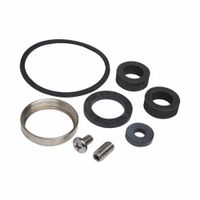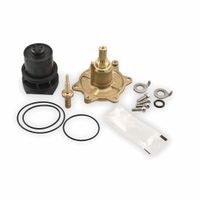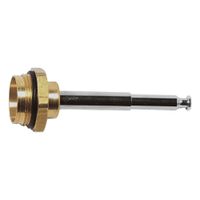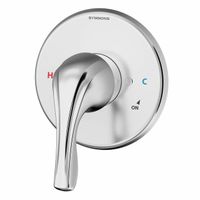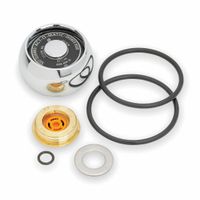Call +(254) 703 030 000 / 751 483 999 / 721 704 777
- Home
- Plumbing
- Bathtubs Showers Repair Parts
- Bathtub Shower Repair Parts
Frequently Asked Questions
What are the most common bathtub and shower repair parts?
The most common bathtub and shower repair parts include:
1. **Faucet Handles and Stems**: These are frequently replaced due to wear and tear. Handles can become loose or corroded, while stems may develop leaks.
2. **Showerheads**: Over time, mineral deposits can clog showerheads, reducing water flow. Replacing or cleaning them is a common repair.
3. **Cartridges**: Found in single-handle faucets, cartridges control water flow and temperature. They can wear out, leading to leaks or temperature issues.
4. **Diverter Valves**: These direct water from the tub spout to the showerhead. They can fail, causing water to flow from both outlets simultaneously.
5. **O-rings and Washers**: These small rubber parts are crucial for preventing leaks in faucets and showerheads. They can degrade over time and need replacement.
6. **Tub Spouts**: These can corrode or become damaged, leading to leaks or improper water flow.
7. **Drain Stoppers**: These can become stuck or fail to seal properly, requiring replacement to ensure proper drainage.
8. **Shower Door Seals and Tracks**: Seals can wear out, leading to water leaks outside the shower. Tracks can become misaligned or damaged.
9. **Caulking**: The sealant around tubs and showers can crack or mold, necessitating removal and reapplication to prevent water damage.
10. **Pressure Balancing Valves**: These maintain consistent water temperature despite pressure changes. They can fail, causing temperature fluctuations.
11. **Shower Pans and Liners**: These can crack or leak, requiring repair or replacement to prevent water damage to the subfloor.
12. **Flanges and Gaskets**: These components ensure a watertight seal between the tub or shower and the plumbing system.
Regular maintenance and timely replacement of these parts can prevent more extensive and costly repairs.
How do I identify the right replacement parts for my bathtub or shower?
1. **Identify the Problem**: Determine what part needs replacement—faucet, showerhead, drain, valve, or other components.
2. **Brand and Model**: Check for any brand or model information on the existing parts. This can often be found on the faucet or showerhead itself, or in any documentation you might have from the original installation.
3. **Take Measurements**: Measure the dimensions of the part needing replacement. For faucets, measure the distance between the centers of the hot and cold water inlets. For showerheads, note the diameter and threading.
4. **Material and Finish**: Identify the material (e.g., chrome, brass, plastic) and finish (e.g., brushed nickel, polished chrome) to ensure the new part matches the existing fixtures.
5. **Type of Fixture**: Determine the type of fixture you have. For example, is it a single-handle or double-handle faucet? Is the showerhead fixed or handheld?
6. **Consult Manuals or Diagrams**: If available, refer to the installation manual or diagrams for your bathtub or shower. These often list part numbers and specifications.
7. **Visit Manufacturer’s Website**: Check the manufacturer’s website for parts lists or customer service contact information. Many manufacturers offer detailed diagrams and part numbers online.
8. **Local Hardware Store**: Bring the old part to a local hardware store for assistance. Staff can often help identify the correct replacement.
9. **Online Research**: Use online resources, forums, or retailer websites to find compatible parts. Websites like Amazon or Home Depot often have customer reviews and Q&A sections that can be helpful.
10. **Professional Assistance**: If unsure, consult a plumber or professional for advice on identifying and sourcing the correct parts.
Where can I buy bathtub and shower repair parts?
You can purchase bathtub and shower repair parts from a variety of sources:
1. **Home Improvement Stores**: Major chains like Home Depot, Lowe’s, and Menards offer a wide selection of repair parts for bathtubs and showers, including faucets, showerheads, drain components, and seals. They also provide in-store assistance and online shopping options.
2. **Plumbing Supply Stores**: Specialized plumbing supply stores often carry a more extensive range of parts and brands. These stores can provide expert advice and may have parts that are not available in general home improvement stores.
3. **Online Retailers**: Websites like Amazon, eBay, and Wayfair offer a vast selection of repair parts with customer reviews and competitive pricing. Online plumbing supply stores like SupplyHouse.com and FaucetDirect.com also provide specialized parts.
4. **Manufacturer Websites**: If you know the brand of your bathtub or shower, visiting the manufacturer’s website can be beneficial. Brands like Kohler, Moen, and Delta offer replacement parts directly through their websites.
5. **Local Hardware Stores**: Smaller, local hardware stores may carry essential repair parts and can offer personalized service and advice.
6. **Specialty Bathroom Stores**: Stores that specialize in bathroom fixtures and accessories may have a selection of repair parts and can offer expert guidance.
7. **Second-Hand Stores**: Habitat for Humanity ReStores and other second-hand stores may have used or surplus parts at a lower cost.
8. **Professional Plumbers**: Hiring a professional plumber can ensure you get the correct parts and proper installation. Many plumbers have access to a wide range of parts and can order specific items if needed.
Consider checking product compatibility and warranty information before purchasing to ensure you get the right parts for your repair needs.
How do I fix a leaking bathtub faucet?
1. **Turn Off Water Supply**: Locate the water shut-off valve for the bathtub and turn it off. If there isn't a specific valve, turn off the main water supply to the house.
2. **Plug the Drain**: Use a drain stopper or a rag to prevent any small parts from falling down the drain.
3. **Remove the Faucet Handle**: Use a screwdriver to remove the screw holding the handle in place. This screw is often located under a decorative cap or at the base of the handle.
4. **Take Off the Handle**: Gently pull the handle off. If it's stuck, use a handle puller tool.
5. **Remove the Escutcheon Plate**: Unscrew and remove the escutcheon plate, which is the decorative plate behind the handle.
6. **Extract the Stem or Cartridge**: Depending on your faucet type, use a wrench to unscrew the packing nut and remove the stem or cartridge. For cartridge faucets, you may need pliers to pull it out.
7. **Inspect and Replace Parts**: Check the washer, O-ring, or cartridge for wear and tear. Replace any damaged parts. For compression faucets, replace the washer and O-ring. For cartridge faucets, replace the entire cartridge if necessary.
8. **Reassemble the Faucet**: Reinsert the stem or cartridge, tighten the packing nut, and replace the escutcheon plate and handle.
9. **Turn On Water Supply**: Turn the water supply back on and check for leaks.
10. **Test the Faucet**: Turn the faucet on and off to ensure it operates smoothly and no longer leaks.
11. **Final Check**: Ensure all parts are securely tightened and the faucet is functioning properly without leaks.
What tools do I need for bathtub and shower repairs?
For bathtub and shower repairs, you will need a variety of tools depending on the specific repair task. Here’s a comprehensive list:
1. **Basic Hand Tools:**
- **Screwdrivers:** Both flathead and Phillips for removing fixtures and panels.
- **Adjustable Wrench:** For loosening and tightening nuts and bolts.
- **Pliers:** Useful for gripping and turning small parts.
- **Utility Knife:** For cutting caulk or sealant.
2. **Plumbing Tools:**
- **Pipe Wrench:** Essential for working with plumbing pipes.
- **Plumber’s Tape (Teflon Tape):** For sealing pipe threads.
- **Plunger:** For unclogging drains.
- **Drain Snake or Auger:** For clearing stubborn clogs.
3. **Caulking Tools:**
- **Caulk Gun:** For applying new caulk around the tub or shower.
- **Caulk Remover Tool:** To remove old caulk efficiently.
4. **Cleaning Supplies:**
- **Scrub Brush:** For cleaning surfaces before repairs.
- **Mild Detergent or Vinegar:** For cleaning and disinfecting.
5. **Repair Materials:**
- **Epoxy or Fiberglass Repair Kit:** For fixing cracks or chips in the tub.
- **Replacement Parts:** Such as washers, O-rings, or showerheads.
6. **Safety Gear:**
- **Gloves:** To protect your hands.
- **Safety Glasses:** To protect your eyes from debris.
7. **Measuring Tools:**
- **Tape Measure:** For accurate measurements.
- **Level:** To ensure installations are even.
8. **Power Tools (if needed):**
- **Drill:** For making holes or driving screws.
- **Jigsaw:** For cutting through materials if necessary.
Having these tools on hand will help you tackle most bathtub and shower repair tasks efficiently.
How do I replace a broken showerhead?
1. **Gather Tools and Materials**: You will need an adjustable wrench, plumber's tape (Teflon tape), and the new showerhead.
2. **Turn Off Water Supply**: While not always necessary, it’s a good precaution to turn off the water supply to avoid any accidental sprays.
3. **Remove the Old Showerhead**: Use the adjustable wrench to grip the base of the old showerhead. Turn it counterclockwise to unscrew. If it’s tight, apply some penetrating oil and wait a few minutes before trying again.
4. **Clean the Shower Arm**: Once the old showerhead is removed, clean the threads of the shower arm with a cloth to remove any debris or old plumber’s tape.
5. **Apply Plumber’s Tape**: Wrap the threads of the shower arm with plumber’s tape. Wrap it clockwise 2-3 times to ensure a good seal and prevent leaks.
6. **Attach the New Showerhead**: Screw the new showerhead onto the shower arm by hand. Turn it clockwise until it’s snug. Use the adjustable wrench to tighten it slightly, but avoid over-tightening as it can damage the threads.
7. **Check for Leaks**: Turn the water supply back on and test the new showerhead. Check for any leaks around the connection. If there are leaks, tighten the showerhead slightly more or add more plumber’s tape.
8. **Adjust and Test**: Adjust the showerhead to your preferred angle and test the water flow to ensure it’s working properly.
9. **Final Check**: Ensure everything is secure and there are no leaks. Enjoy your new showerhead!
Can I repair a cracked bathtub myself?
Yes, you can repair a cracked bathtub yourself, provided you have the right tools and materials. First, assess the type of material your bathtub is made from, such as fiberglass, acrylic, or porcelain, as this will determine the repair method.
For fiberglass or acrylic tubs, start by cleaning the area around the crack with a non-abrasive cleaner and drying it thoroughly. Sand the cracked area lightly with fine-grit sandpaper to create a rough surface for better adhesion. Apply a fiberglass repair kit, which typically includes resin, hardener, and fiberglass cloth. Mix the resin and hardener according to the instructions, apply it over the crack, and place the fiberglass cloth on top. Smooth it out and let it cure completely. Once dry, sand the area again to ensure a smooth finish and apply a matching touch-up paint if necessary.
For porcelain tubs, clean the area and dry it. Use a porcelain repair kit, which usually contains epoxy or a similar compound. Mix the components as directed and apply the mixture to the crack with a spatula or applicator. Allow it to dry and sand it smooth. You may need to apply a porcelain touch-up paint to match the tub's color.
In both cases, ensure proper ventilation and follow safety precautions, such as wearing gloves and a mask. If the crack is extensive or the tub is severely damaged, it might be more cost-effective to consult a professional or consider replacement.
